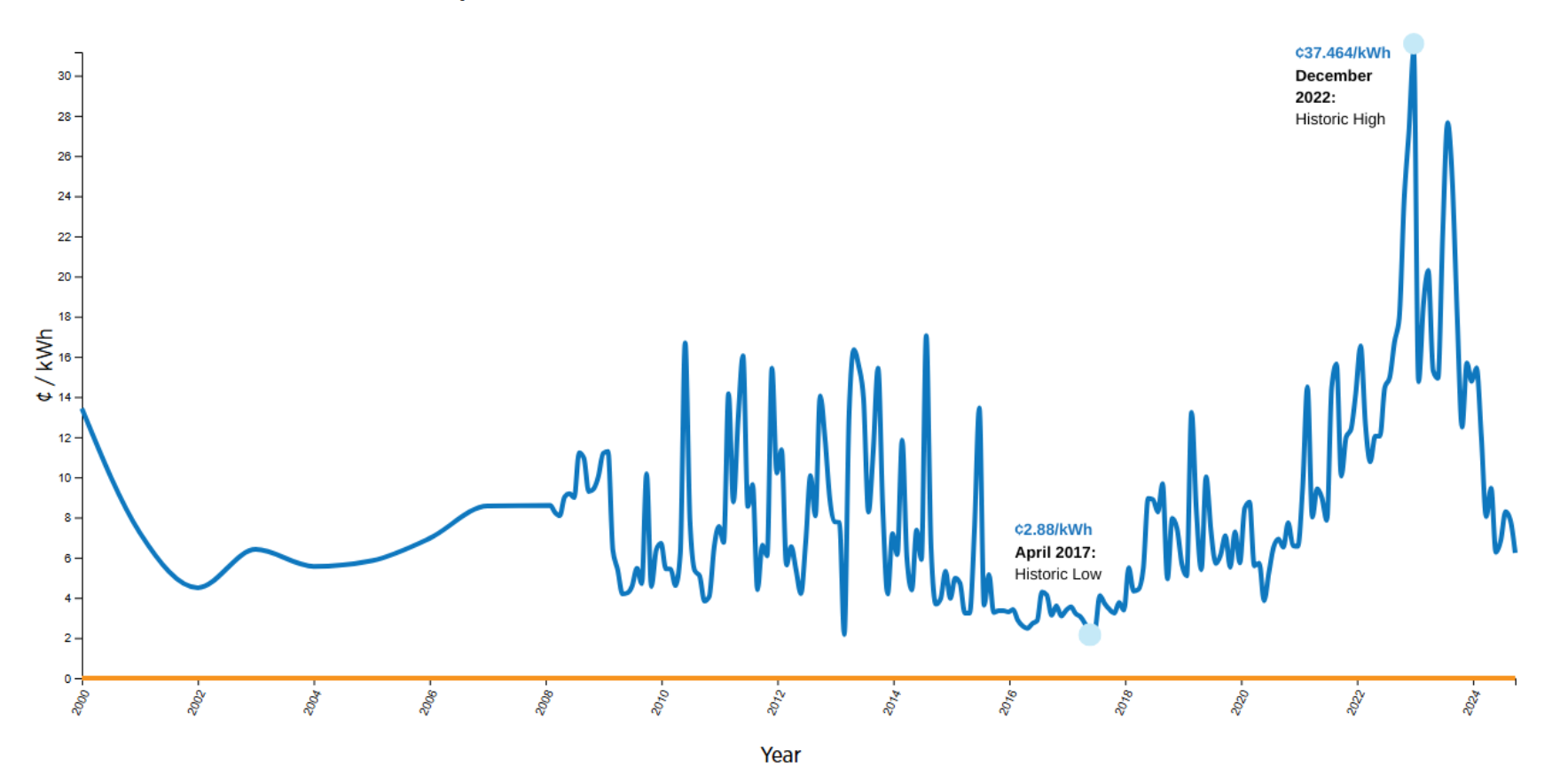Is It Fair To Assume that Albertans are Paying More for Electricity Year over Year?

Source: https://energyrates.ca/here-is-what-alberta-electricity-rates-look-like-right-now
Short answer: over the long run, yes—Albertans have faced an upward trend in electricity costs, even though the energy portion has swung wildly (and even eased lately). The climb has been driven mostly by delivery charges (distribution + transmission) and policy riders layered on top of the commodity price. Below, we walk through what’s leading to the upward trend.
1) What’s on your bill (and what’s been rising)
Your total electricity bill = Energy (¢/kWh) + Delivery (fixed + variable distribution & transmission) + riders/fees/taxes.
- Delivery charges have trended up for years as utilities build and maintain the grid. The Utilities Consumer Advocate (UCA) notes Alberta has seen increases in transmission charges since 2004 because of large projects, with 2024 monthly transmission charges for an average home (600 kWh) ranging roughly $23–$31 depending on service area. Distribution charges for that same 600 kWh ranged roughly $32–$101—higher in rural areas. ucahelps.alberta.ca
- The UCA’s delivery-charges page also explains why some locations pay more (longer lines, lower density), which is a structural headwind on bills irrespective of energy prices. ucahelps.alberta.ca
- Alberta Municipalities summarize how geography drives big differences in delivery costs—some communities pay up to 3:1 more than others—another long-term pressure point. Alberta Municipalities
2) The energy price: spiky spikes…then a pullback
- Alberta’s wholesale “pool price” exploded in 2022–2023, then cooled in 2024–2025. In late October 2025 the daily average pool price was around $29/MWh (≈2.9¢/kWh), far below 2023 peaks. (Wholesale ≠ retail, but it shows the underlying market easing lately.) ets.aeso.ca
- During the run-up, many Regulated Rate Option (RRO) customers saw monthly energy rates >25–30¢/kWh in 2023, which made headlines. The Tyee
- To blunt those spikes, the province capped RRO at 13.5¢/kWh for Jan–Mar 2023 and deferred the extra cost to be repaid later (April 2023–Dec 2024). That deferral kept bills lower then but added charges later, contributing to elevated bills through 2024. Global News+2EnergyRates.ca+2
3) 2025 changed the default: RRO ➜ Rate of Last Resort (RoLR)
- As of January 1, 2025, Alberta replaced the monthly-floating RRO with the RoLR, a fixed rate set for two years (can change up to ±10% at each 2-year reset). It varies by service area:
- Direct Energy Regulated Services: 12.02¢/kWh (Jan 1, 2025–Dec 31, 2026). Direct Energy
- EPCOR: 12.01¢/kWh for the 2025–2026 term. EPCOR
- City of Red Deer (municipal default): 12.06¢/kWh listed. Red Deer
What this means: even if the commodity market cools, the RoLR energy line won’t drop each month the way RRO did in a down-market—so consumers won’t see immediate energy-line savings unless they choose a competitive-market plan below RoLR. Meanwhile, delivery components continue on their own trajectory.
4) Delivery & riders keep nudging totals up
- Transmission/Distribution riders regularly true-up prior-period costs (e.g., AESO transmission access charges), which can add temporary increases to bills. See AUC rider explainer and recent filings (e.g., ENMAX TAC rider; FortisAlberta rider schedules). AUC+2media.auc.ab.ca+2
- Even where interim “non-energy” rate components jumped, regulators note the total monthly bill impact might be smaller (because non-energy is a subset of the bill) — but it’s still upward pressure. prd-api-efiling20.auc.ab.ca
- ATCO’s rate page shows Jan 1, 2025 distribution rates up ~5.2% (with a transmission decrease partly offsetting)—illustrating how delivery adjustments continue year-to-year. electric.atco.com
- Independent write-ups (and bill breakdowns) also show meaningful multi-year increases in delivery fees in major cities (e.g., Calgary/ENMAX). While blogs aren’t primary sources, their screenshots and references align with the UCA trends above. Glean
5) Inflation data backs the big-picture direction
- Statistics Canada’s CPI for electricity (provincial detail available in the CPI tables and Alberta’s official dashboard) shows electricity costs have trended higher over the decade, even with year-to-year volatility. That’s consistent with what households feel: spikes in 2022–23, some relief in 2024–25 on energy, but the overall level remains well above the mid-2010s. Statistics Canada+1
6) So…are prices “generally rising”?
Putting it all together:
- Long-term: delivery charges and periodic riders have ratcheted up the non-energy portion for years, lifting the floor of total bills. ucahelps.alberta.ca+1
- Short-to-medium-term: the energy line spiked dramatically in 2022–23, then eased in 2024–25; however, the new RoLR fixes default energy near ~12¢/kWh for 2025–26, limiting how much default customers benefit from lower wholesale prices unless they switch plans. Direct Energy+2EPCOR+2
- Net effect for many homes: despite recent energy-market relief, total bills remain structurally higher than in the 2010s because delivery/rider components have climbed and the default energy rate is now fixed above historical lows. ucahelps.alberta.ca+1
Conclusion: Yes—in general, the cost of electricity service in Alberta has risen over time, with delivery charges and riders doing much of the heavy lifting, while commodity prices add cycles on top. Recent policy changes (RoLR) also shape what default customers pay in 2025–26.
Quick reference list
- UCA: Historic energy rates (RRO/variable) trend charts. ucahelps.alberta.ca
- UCA: Residential delivery charges (2024 ranges; why they vary). ucahelps.alberta.ca+1
- AUC: Monthly residential rates at a glance; rate riders; how rates are set. AUC+2AUC+2
- AESO: Annual market stats & hourly/pool price data; daily pool price report. AESO+2AESO+2
- StatCan & AB Dashboard: CPI trend for electricity. Statistics Canada+1
- Government/News & explainers: 2023 RRO cap at 13.5¢/kWh + deferral. Global News+2EnergyRates.ca+2
- 2025 policy change: RoLR replaces RRO, ~12.0–12.06¢/kWh examples (provider pages). Red Deer+3ucahelps.alberta.ca+3Direct Energy+3
- Examples of transmission access charge riders / schedules (mechanism for bill add-ons). media.auc.ab.ca+1
What you can do next
- Audit your bill (what % is energy vs delivery?). If the energy part is high relative to RoLR or competitive offers, consider locking a competitive fixed rate below RoLR. Check options via UCA retailer lists. ucahelps.alberta.ca
- Reduce delivery-driven usage charges where possible (efficiency, load shifting). These won’t erase fixed fees but help with the variable portion.
- For businesses or high-consumption homes, keep an eye on AUC rider filings and AESO updates; they often foreshadow non-energy adjustments. AUC+1
